Guide to completing QCAT form 2 Application for minor civil dispute – Residential Tenancy Dispute
QCAT can hear residential tenancy or rooming accommodation disputes that are covered under the Residential Tenancies and Rooming Accommodation Act 2008 (Qld) (the Act).
The Tenants Queensland website includes a series of short videos to assist people when they need to go to QCAT for a residential tenancy hearing. The videos show the steps tenants can take to solve a tenancy dispute, or apply to QCAT for a hearing and a final decision.
The Applicant will need to provide a completed and signed the QCAT Form 2 Application for Minor Civil Dispute – residential tenancy dispute, include attachments and supporting statements or evidence. Additional copies will need to be provided for each party including the Applicant; QCAT will serve all the parties the QCAT application along with a Notice of Hearing.
Copies of the Application must be lodged at the local Magistrates Court (closest to the rental premises) that hears QCAT matters, or at the central QCAT registry in Queen St Brisbane.
The Applicant will need to pay a QCAT filing fee. This fee will depend on the amount of money that is being claimed in the application. See the QCAT website for a full list of fees (these change each year).
If the Applicant is low income and cannot afford to pay the QCAT filing fee they can fill in a QCAT QCAT Form 49 Application for waiver of fees by reason of financial hardship. They need to attach evidence as proof of low income, such as a copy of a pension or health care card, or a statement regarding current financial difficulties.
PAGE 1 The Applicant’s Details
The Applicant is the person applying to QCAT for a hearing. Include their details on Page 1. If other tenants are named on the tenancy agreement, they need to be included as Respondents on page 2, if they are not also an Applicant in the matter.
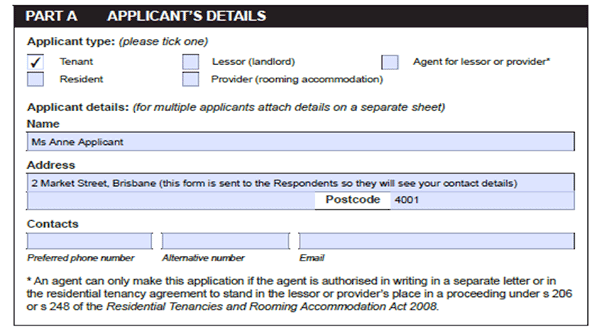
PAGE 2 The Rental Property
Include the tenancy details here. State the address and information about the rental bond.
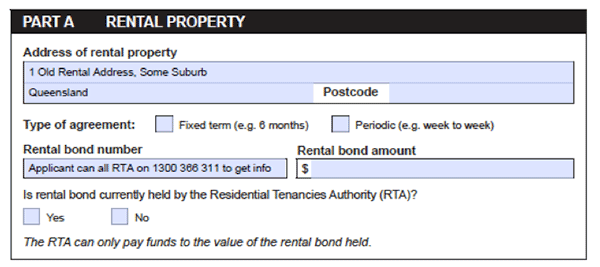
If you don’t know the bond details bond contributors can call the RTA on 1300 366 311 to get their bond number and verify the amount of bond being held by the RTA.
Applicants can also attach a copy of the tenancy agreement to the application (if they have a copy)
PAGE 2 The Respondent’s Details
The Respondent/s is the other party; usually the lessor or agent. Other co-tenants must also be listed as Respondents (if they are not named as Applicants).
Insert an extra piece of paper if you need to list contact details for additional respondents.
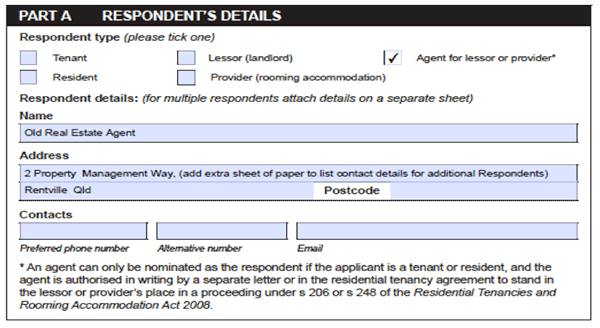
Most tenants only have contact details for the Agent who stand in the place of the lessor. However the Applicant can name both the lessor and agent if they wish.
If seeking an order to remove a tenancy database listing the Applicant should name both the listing agent and the database company (eg:TICA) as Respondents.
Urgent or Non-urgent Applications
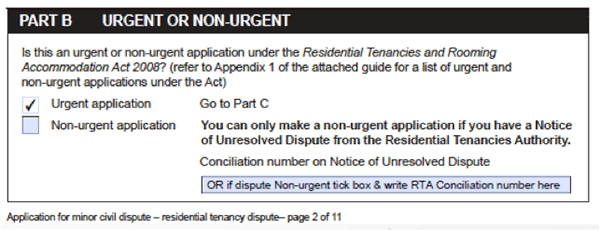
Tick a box to say whether the application is an Urgent application or Non-urgent application. See the Appendix (pages 8 to 10) for a list of all Urgent and non-urgent applications.
Urgent applications are defined in s415 of the Residential Tenancies and Rooming Accommodation Act 2008. QCAT prioritise hearings for Urgent applications. Urgent QCAT applications include applications to terminate a tenancy or dispute a dispute a tenancy database listing.
For non-urgent applications (such as bond or compensation disputes) parties must first apply to the RTA using a Form 16 and seek conciliation of the dispute before they can apply to QCAT for a hearing. The RTA will send out a Notice of Unresolved Dispute, which includes a conciliation number, if they are unable to assist the parties resolve the dispute, this number is to be included in the application.
Non-urgent tenancy matters may include bond disputes, compensation claims, disputes about service charges or water bills, or general disputes about the agreement.
PAGE 3 The Order and Reasons Details -Part C
What section of the Act are you applying under? Write the section number here.
Look at the Appendix (pages 8 to 10) at the end of the Form 2 for a list of all urgent and non-urgent QCAT applications. Seek advice if you don’t know which section to use.
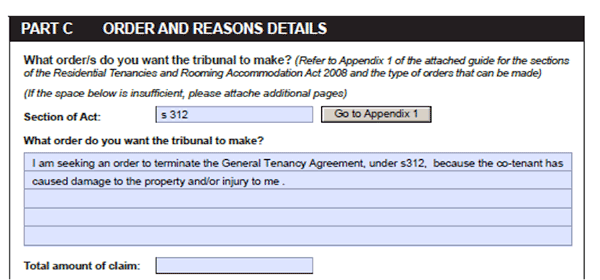
State here what order you want QCAT to make at the hearing. This will relate to the section you have applied under.
The section number will depend on:
-the type of tenancy dispute,
– the order being requested
– the type of tenancy (eg: general tenancy or rooming accommodation) and
– if the person applying for the hearing is a tenant, resident, co-tenant, occupant or domestic associate.
For example an application under s312 to terminate a co-tenancy due to damage or injury by a co-tenant can state this here. An application to QCAT for a non-urgent bond dispute hearing under sections 137 and section 429 (general dispute) could state “I met all my obligations as a tenant and am seeking an order that my bond of $ XXXX.XX be refunded to me.
If seeking a monetary amount write the amount in the box (such as the bond amount). In the box below the Applicant can list any compensation they are seeking. List the item being claimed and the amount. The Applicant will also need to attach supporting evidence such as photos and receipts as proof to justify these claims.
If the Applicant has issued or received any tenancy notices and they are relevant to the matter in dispute, they can be listed in the space provided.
PAGE 4 – What are your reasons for seeking the above orders?
The Applicant should state the reasons for the orders they are seeking. The reasons should be detailed enough so that the other party can understand what the dispute is about. The Applicant can also refer to attached supporting evidence, which should be clearly labeled.
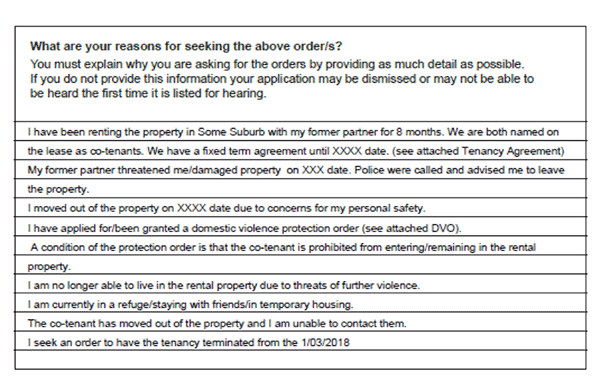
An Applicant may provide evidence by attaching a statement or an Affidavit to the application. They can flag their evidence by writing “see attached Affidavit or Statement”. Depending on the type of tenancy dispute evidence may include relevant letters, emails, photos, receipts or tenancy forms. It is always a good idea to keep statements brief (1-2 pages). If the matter is complex (such as a bond dispute) number the paragraphs and refer to relevant evidence that should be attached.
If someone is unable to attend a QCAT hearing to put forward their evidence in person, they may provide evidence in an Affidavit, which should be attached to the application. Additionally, the person should be available to attend the hearing by teleconference if the Tribunal wishes to ask them question about their evidence.
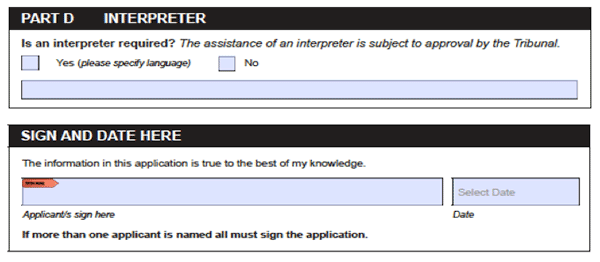
If an interpreter is needed at the hearing let QCAT know in advance. Tick this box. It is also a good idea to make a written request. Liaise with QCAT to see if they can provide an interpreter as requested. Applicants or Respondents may also need to organise their own interpreter support.
All Applicants need to sign and date the application here. If there is more than one Applicant the second Applicant can sign the form in the space below.